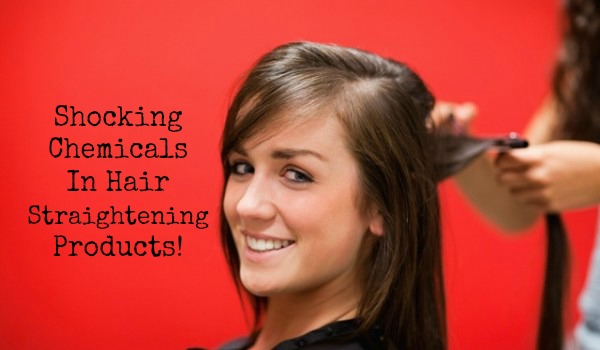Hair Straightening Products
We live in a time where you can do almost anything you want to your hair and it will look “somewhat natural”. Thirty years ago, if you wanted to straighten your hair, and it was super curly, most hair dressers would give you your money back {according to my mother who has exceptionally curly hair}. I have even heard that women used an actual iron! – yep, the iron!
The most popular tool used today in households, is the good old ceramic hair straightener. The technology on these suckers has become quite advanced; some even have silver nanoparticles in them to increase the heat distribution and effectiveness of the product at lower temperatures (i.e. you wont burn your hair).
Heat Protection Spray Review
The main problem is in the “heat protecting spray!” Yes, it does miracles for your hair and helps it to also look “red-carpet shinny”, but have you ever considered why?
There are often at least 30 chemicals in each spray bottle!! Some of which are known to be carcinogenic! {I was shocked to learn this in the scientific literature}. The main chemical of concern however is formaldehyde and formaldehyde-releasing preservatives (FRPs)
What Is Formaldehyde?
Formaldehyde releasing preservatives are commonly used in place of formaldehyde, and release small amounts of formaldehyde over time.[i] The purpose of these chemicals is to prevent bacteria from growing in water-based products.
WHAT TO LOOK FOR ON THE LABEL:
Main “formaldehyde-releasing preservatives” in products today:
-
Quaternium-15 (**the most sensitizing of these FRPs)
- Dimethyl (DMDM) hydantoin
- imidazolidinyl urea
- Diazolidinyl urea
- Sodium hydroxymethylglycinate
- 2-bromo-2-nitropropane-1
- 3-diol (bronopol)
Formaldehyde Dangers To Health
Formaldehyde is considered a known human carcinogen by many expert and government bodies, including the United States National Toxicology Program[iii] and the International Agency for Research on Cancer.[iv] A shocking 2009 review of the literature on occupational exposures and formaldehyde shows a link between formaldehyde and leukemia.[v] Formaldehyde in cosmetic is also widely udnerstood to cause allergic skin reactions and rashes in some people.[vi],[vii]
Since low levels of formaldehyde can cause health concerns – at levels as low as 250 parts per million[viii], and even lower levels in sensitized individuals[ix] – the slow release of small amounts of formaldehyde are cause for concern.
When formaldehyde is present in a product, people can be exposed by either inhaling it or absorbing it through the skin. Inhalation usually occurs from the off-gas of the product. Animals studies indicate that formaldehyde can be absorbed through the skin when formaldehyde-containing personal care products, including formaldehyde-releasing preservatives are applied.[x]
Other Personal Care Products That Contain Formaldehyde and Formaldehyde-Releasing Preservatives?
Besides, hair straightening spray, these chemicals can be found in shampoos and liquid baby soaps. Nail polish, nail glue and eyelash glue also contain them.
REFERENCES
[i] Moennich JN, Hanna DM, Jacob SE (2009). Formaldehyde-releasing preservative in baby and cosmetic products. Journal of the Dermatology Nurses’ Association 1:211-214.
[ii] Jacob SE, Breithaupt A (2009). Environmental Exposures – A pediatric perspective on allergic contact dermatitis. Skin & Aging. July 2009: 28-36.
[iii] U.S. Department of Health and Human Services, Public Health Service, National Toxicology Program. ”Formaldehyde (Gas) CAS No. 50-00-0: Reasonably anticipated to be a human carcinogen.” Eleventh Report on Carcinogens. December 2002. Available at: http://ntp.niehs.nih.gov/ntp/roc/eleventh/profiles/s089form.pdf. Accessed October 16, 2009.
[iv] International Agency for Research on Cancer. “IARC classifies formaldehyde as carcinogenic to humans.” Press release. June 15, 2004. www.iarc.fr/en/Media-Centre/IARC-Press-Releases/Archives-2006-2004/2004/IARC-classifies-formaldehyde-as-carcinogenic-to-humans. Accessed January 9, 2009.
[v] Zhang et al 2009. Meta-analysis of formaldehyde and hematologic cancers in humans. Mutation Research 681: 150-168.
[vi] Flyvholm MA, Menné T. Allergic contact dermatitis from formaldehyde. A case study focusing on sources of formaldehyde exposure. Contact Dermatitis. 1992 Jul;27(1):27-36.
[vii] Boyvat A, Akyol A, Gürgey E. Contact sensitivity to preservatives in Turkey. Contact Dermatitis. 2005;52(6):333-337.
[viii] Flyvholm MA, Hall BM, Agner T, Tiedemann E, Greenhill P, Vanderveken W, Freeberg FE, Menné T. Threshold for occluded formaldehyde patch test in formaldehyde-sensitive patients. Relationship to repeated open application test with a product containing formaldehyde releaser. Contact Dermatitis. 1997;36(1):26-33.
[ix] Jordan WP Jr., Sherman WT, King SE. Threshold responses in formaldehyde-sensitive subjects. J Am Acad Dermatol. 1979;1(1):44- 8. Also confirmed by personal communication between Dr. Sharon Jacob and Stacy Malkan, February 26, 2009.
[x] Bartnik FG, Gloxhuber C, Zimmermann V. Percutaneous absorption of formaldehyde in rats. Toxicol Lett. 1985;25(2):167-72.




